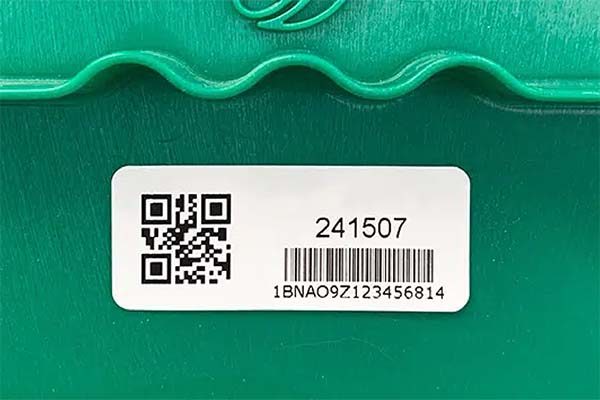Pallets enter the information age
Demand is on the rise for sensor-driven connected solutions that can help streamline logistics operations. Smart pallets may be the answer.

Warehousing and logistics professionals are living in the supply chain information age, where technology is helping them create smoother-running, more efficient operations. The proof is everywhere you look—from robotics and automation on the warehouse floor, to tech platforms that streamline back-office operations, to the smart devices used in the cabs of delivery vehicles—and it’s giving supply chain managers access to information that can help their companies meet customer demands for timeliness, product quality, safety, and much more.
A growing place for data mining is the pallet, which can be equipped with sensor-driven devices that monitor the condition and track the whereabouts of products on their journey from the warehouse to the end-customer. “Smart pallets,” as they’re known, are an emerging technology in the supply chain, and one that proponents say can reveal broad trends in logistics operations that lead to better decision making.
“I think [this technology] really shines a light on the invisible parts of your supply chain,” says Mike Vaughan, senior project manager in the engineering services department at reusable packaging manufacturer Orbis Corp., which makes plastic pallets and containers, among other products. “You may actually see that a customer tends to sit on things for a week and a half, and say ‘Let’s see why.’ You may see variations in the [pallets’] return loop. It’s definitely a discussion starter.”
Those discussions can prompt better strategies for preventing theft and pilferage, ensuring compliance with regulatory requirements, and meeting on-time delivery goals, among others. All of this is a driving force in the growth of the smart pallet market: Recent data from research firm Coherent Market Insights indicates that demand for smart pallet sensors will increase at a compound annual growth rate (CAGR) of 4% over the next seven years, for example. Pallet companies and tech firms are working together to capitalize on that growth, with the ultimate goal of streamlining supply chains.
“[Smart pallet development] is a learning process for everyone,” Vaughan adds. “It’s not just ‘Where is my asset at what time?’ It’s about what value that information has for you, and how it [can] help streamline your business.”
THE EVOLUTION OF “SMART”
In the most general terms, a “smart” pallet is one that contains a device with a sensor and tracker that allows supply chain managers and other stakeholders to monitor the pallet’s location, movement, and environment. The devices can be integrated into any kind of pallet and can be used to detect and report delays as well as other potentially disruptive events along the pallet’s journey—things like changes in temperature or humidity and the mishandling of goods. The use of such pallets is still in the early stages and is largely tied to the integration of advanced warehouse automation systems.
“The implementation of these pallets is especially useful in industries such as the food, chemical, and pharmaceutical sectors, where [changes in ambient] conditions can affect product quality and safety. The sensors detect changes in pallet temperature or humidity levels so that the logistics manager can move the goods before they start to deteriorate,” according to research from warehouse storage solutions company Interlake Mecalux. “Investment in smart pallets tends to go hand in hand with warehouse process automation to ensure full control over inventory. Automation eliminates the margin of error due to manual intervention and, most importantly, optimizes the movements made by each pallet.”
But such implementations are far from mainstream. And in many ways, smart pallets represent the next step in the evolution of intelligent packaging solutions designed to control the movement of goods through the supply chain: Vaughan points to simple bar-code labels and radio-frequency identification (RFID) tags as examples of ways companies have been adding intelligence to pallets for years, primarily for identification purposes. But he agrees that demand for more advanced solutions is on the rise and says Orbis’ customers are increasingly asking how they can take the technology to the next level with tracking and sensing devices.
“I would say, still today, the most prevalent [pallet technology] is some sort of adhesive label that has some kind of bar code or RFID,” Vaughan says, adding that cost and return on investment are the biggest deterrents when it comes to adding any form of technology to a pallet. “But we are seeing … requests on a pretty frequent basis to get into starting a trial, or doing a proof of concept and pilot, with [devices that include trackers and sensors].”
Such trials must be tailored to customers’ needs. Vaughan says Orbis is working on a proof of concept now that required altering a pallet design to accommodate a cellular-based tracker that includes global positioning system (GPS) technology; the device needed to be mounted in such a way that it wouldn’t be knocked off or damaged during transit and handling. Orbis determined the tracker could be mounted inside the pallet’s center foot—a support structure located on the bottom of the pallet—with a cap to protect it from the elements.
“You don’t want to put a tracker on the exterior plane or top, or somewhere it can be damaged or affected in a way that’s detrimental to the trial,” Vaughan explains, adding that from here on out, many of Orbis’ new products will be designed with a recessed space to accommodate tracking and sensing devices—a response to growing demand for such solutions.
Pallet and container pooling specialist CHEP is in the game as well. The company has partnered with supply chain technology company BXB Digital to equip CHEP’s reusable wooden pallets with track-and-trace devices across Southern Europe. The technology is helping customers in the region gain greater control and security over inventory, while also protecting pallets from getting lost and taken out of circulation—pallet pooling is a share-and-reuse system, in which companies rent pallets that are then managed by an outside firm, a sort of “pallets-as-a-service” business. In the CHEP/BXB Digital program, pallets are equipped with built-in sensor devices that collect information on the location and condition of the pallets—including temperature—as they move through the supply chain. Eleven retailers and distributors are participating in the trials, with more to follow, according to CHEP.
IOT, E-COMMERCE DRIVE DEMAND
Recent technological advances are playing the biggest role in smart pallet development, particularly the internet of things (IoT), which is what transforms the otherwise static pallet into a smart, connected device—as is the case with both the Orbis and CHEP pilot programs. The advent of 5G and other high-speed communication technologies has pushed development even further, allowing data transmission between the pallet’s sensors and a company’s supply chain IT systems to occur seamlessly and, in many cases, instantaneously. Greater speed and easier connectivity also open the door to better integration with other technologies, such as artificial intelligence (AI) and machine learning (ML), which provide the insight and analytics required to identify those trends and patterns that are essential to better supply chain decision making, according to the Coherent Market Insights report.
The rise in e-commerce activity since 2020 is also playing a role by boosting demand for advanced inventory tracking systems. The higher volume of goods flowing through the supply chain—along with demand for faster delivery—is driving the need for technologies that increase visibility and efficiency across a company’s entire logistics operation.
More recently, government regulations and standards have helped propel the smart pallet into the spotlight, particularly in the food and pharmaceutical industries. A case in point: Section 204 of the U.S. Food and Drug Administration’s Food Safety Modernization Act (FSMA), which will take full effect in a little over two years. FSMA 204, as it’s known, requires enhanced information sharing and data tracking along the food supply chain—essentially, many companies that handle goods in the food chain will need to upgrade their shipment tracking abilities and be able to share the data with suppliers, wholesalers, distributors, stores, and restaurants at a moment’s notice. Those companies will almost certainly have to turn to automated technologies—like sensor-equipped smart pallets and advanced software systems—to make it all work.
“There are data requirements that, without this type of technology, would be impossible,” says Vaughan, pointing to FSMA 204 as well as the Drug Supply Chain Security Act (DSCSA), which goes into effect this year. “It’s so important to stay up to date on new use cases and advances in this technology. Companies need to understand what’s out there, [select the proper technology], and tailor it to their [business].”
Copyright ©2024. All Rights ReservedDesign, CMS, Hosting & Web Development :: ePublishing